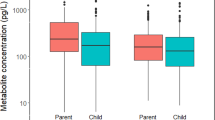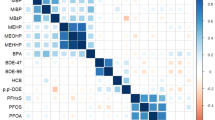Abstract
Recent studies have linked increased polycyclic aromatic hydrocarbons (PAHs) in air and adverse fetal health outcomes. Urinary PAH metabolites are of interest for exposure assessment if they can predict PAHs in air. We investigated exposure to PAHs by collecting air and urine samples among pregnant women pre-selected as living in “high” (downtown and close to steel mills, n=9) and “low” (suburban, n=10) exposure areas. We analyzed first-morning urine voids from all 3 trimesters of pregnancy for urinary PAH metabolites and compared these to personal air PAH/PM2.5/NO2/NOX samples collected in the 3rd trimester. We also evaluated activities and home characteristics, geographic indicators and outdoor central site PM2.5/NO2/NOX (all trimesters). Personal air exposures to the lighter molecular weight (MW) PAHs were linked to indoor sources (candles and incense), whereas the heavier PAHs were related to outdoor sources. Geometric means of all personal air measurements were higher in the “high” exposure group. We suggest that centrally monitored heavier MW PAHs could be used to predict personal exposures for heavier PAHs only. Urine metabolites were only directly correlated with their parent air PAHs for phenanthrene (Pearson's r=0.31–0.45) and fluorene (r=0.37–0.58). Predictive models suggest that specific metabolites (3-hydroyxyfluorene and 3-hydroxyphenanthrene) may be related to their parent air PAH exposures. The metabolite 2-hydroxynaphthalene was linked to smoking and the metabolite 1-hydroxypyrene was linked to dietary exposures. For researchers interested in predicting exposure to airborne lighter MW PAHs using urinary PAH metabolites, we propose that hydroxyfluorene and hydroxyphenanthrene metabolites be considered.
This is a preview of subscription content, access via your institution
Access options
Subscribe to this journal
Receive 6 print issues and online access
$259.00 per year
only $43.17 per issue
Buy this article
- Purchase on Springer Link
- Instant access to full article PDF
Prices may be subject to local taxes which are calculated during checkout


Similar content being viewed by others
References
Aquilina N.J., Delgado-saborit J.M., Meddings C., Baker S., Harrison R.M., and Jacob P., et al. Environmental and biological monitoring of exposures to PAHs and ETS in the general population. Environ Int 2010: 36: 763–771.
Agency for Toxic Substances and Disease Registry (ATSDR). Toxicological profile for polycyclic aromatic hydrocarbons. US Department of Health and Human Services, Public Health Service; available from: http://www.atsdr.cdc.gov/ToxProfiles/tp69.pdf) 1995.
Bosetti C., Nieuwenhuijsen M.J., Gallus S., Carlo La Vecchia C., and Parazzini F. Ambient particulate matter and preterm birth or birth weight: a review of the literature. Arch of Toxicol 2010: 84: 447–460.
Brzeznicki S., Jakubowski M., and Czerski B. Elimination of 1-hydroxypyrene after human volunteer exposure to polycyclic aromatic hydrocarbons. Int Arch of Occ Environ Health 1997: 70: 257–260.
Buckley T.J., and Lioy P.J. An examination of the time course from human dietary exposure to polycyclic aromatic hydrocarbons to urinary elimination of 1-hydroxypyrene. Br J Ind Med 1992: 49: 113–124.
Canadian Environmental Protection Act (CEPA). Priority substances list assessment report — polycyclic aromatic hydrocarbons, 1994. Environment Canada, Health Canada; available from: http://www.hc-sc.gc.ca/ewh-semt/alt_formats/hecs-sesc/pdf/pubs/contaminants/psl1-lsp1/hydrocarb_aromat_polycycl/hydrocarbons-hydrocarbures-eng.pdf.
Castaño-Vinyals G., D’Errico A., Malats N., and Kogevinas M. Biomarkers of exposure to polycyclic aromatic hydrocarbons from environmental air pollution. J Occup Environ Med 2004: 61: e12.
Choi H., Perera F., Pac A., Wang L., Flak E., and Mroz E., et al. Estimating individual-level exposure to airborne polycyclic aromatic hydrocarbons throughout the gestational period based on personal, indoor, and outdoor monitoring. Environ Health Perspect 2008b: 116: 1509–1518.
Choi H., Rauh V., Garfinkel R., Tu Y., and Perera F.P. Prenatal exposure to airborne polycyclic aromatic hydrocarbons and risk of intrauterine growth restriction. Environ Health Perspect 2008a: 116: 658–665.
Delgado-Saborit J.M., Aquilina N., Meddings C., Baker S., Vardoulakis S., and Harrison R.M. Measurement of personal exposure to volatile organic compounds and particle associated PAH in three UK regions. Environ Sci Technol 2009: 43: 4582–4588.
Georgiadis P., Stoikidou M., Topinka J., Kaila S., Gioka M., and Katsouyanni K., et al. Personal exposures to PM 2.5 and polycyclic aromatic hydrocarbons and their relationship to environmental tobacco smoke at two locations in Greece. J Expo Anal Environ Epidemiol 2001: 11: 169–183.
Hansen A.M., Mathiesen L., Pedersen M., and Knudsen L.E. Urinary 1-hydroxypyrene (1-HP) in environmental and occupational studies — a review. Int J Hyg Environ Health 2008: 211: 471–503.
Jongeneelen F.J., van Leeuwen F.E., Oosterink S., Anzion R.B., van der Loop F., and Bos R.P., et al. Ambient and biological monitoring of cokeoven workers: determinants of the internal dose of polycyclic aromatic hydrocarbons. Br J Ind Med 1990: 47: 454–461.
Leroyer A., Jeandel F., Maitre A., Howsam M., Deplanque D., and Mazzuca M., et al. 1-Hydroxypyrene and 3-hydroxybenzo[a]pyrene as biomarkers of exposure to PAH in various environmental exposure situations. Sci Total Environ 2010: 408: 1166–1173.
Li A., Schoonover T.M., Zou Q., Norlock F., Conroy L.M., and Scheff P.A., et al. Polycyclic aromatic hydrocarbons in residential air of ten Chicago area homes: concentrations and influencing factors. Atmos Environ 2005: 39: 3491–3501.
Li Z., Mulholland J.A., Romanoff L.C., Pittman E.N., Trinidad D.A., and Lewin M.D., et al. Assessment of non-occupational exposure to polycyclic aromatic hydrocarbons through personal air sampling and urinary biomonitoring. J Environ Monitor 2010: 12: 1110–1118.
Li Z., Romanoff L.C., Trinidad D.A., Hussain N., Jones R.S., and Porter E.N., et al. Measurement of urinary monohydroxy polycyclic aromatic hydrocarbons using automated liquid–liquid extraction and gas chromatography/isotope dilution high-resolution mass spectrometry. Anal Chem 2006: 78: 5744–5751.
Li Z., Sandau C.D., Romanoff L.C., Caudill S.P., Sjodin A., and Needham L., et al. Concentration and profile of 22 urinary polycyclic aromatic hydrocarbon metabolites in the US population. Environ Res 2008: 107: 320–331.
Llop S., Ballester F., Estarlich M., Ibarluzea J., Manrique A., Rebagliato M., Esplugues A., and Iñiguez C. Urinary 1-hydroxypyrene, air pollution exposure and associated life style factors in pregnant women. Sci Total Environ 2008: 407 (1): 97–104.
Martí-cid R., Llobet J.M., Castell V., and Domingo J.L. Evolution of the dietary exposure to polycyclic aromatic hydrocarbons in Catalonia, Spain. Food Chem Toxicol 2008: 46: 3163–3171.
Mucha A.P., Hryhorczuk D., Serdyuk A., Nakonechny J., Zvinchuk A., and Erdal S., et al. Urinary 1-hydroxypyrene as a biomarker of PAH exposure in 3-year-old Ukrainian children. Environ Health Perspect 2006: 114: 603–609.
Perera F.P., Tang D., Whyatt R., Lederman S.A., and Jedrychowski W. DNA damage from polycyclic aromatic hydrocarbons measured by benzo [a] pyrene–DNA adducts in mothers and newborns from northern Manhattan, the world trade center area, Poland, and China. Cancer Epidemiol Biomarkers Prev 2005: 14: 709–714.
Rajput N., Pyari A.A., Saini M.K., Kumari K.M., and Lakhani A. Assessment of PAH toxicity and mutagenicity in emissions from coal and biofuel combustion. J Environ Sci Eng 2010: 52 (3): 185–192.
Sahsuvaroglu T., Arain A., Kanaroglou P., Finkelstein N., Newbold B., and Jerrett M., et al. A land use regression model for predicting ambient concentrations of nitrogen dioxide in Hamilton, Ontario, Canada. J Air Waste Manage Assoc 2006: 56: 1059–1069.
Singer B., Hodgson A., and Nazaroff W.W. Gas-phase organics in environmental tobacco smoke: 2. Exposure-relevant emission factors and indirect exposures from habitual smoking. Atmos Environ 2003: 37: 5551–5561.
Suzuki Y, Niwa M, Yoshinaga J, Mizumoto Y, Serizawa S, and Shiraishi H Prenatal exposure to phthalate esters and PAHs and birth outcomes. Environ Int 2010: 36 (7): 699–704.
Tonne C.C., Whyatt R.M., Camann D.E., Perera F.P., and Kinney P.L. Predictors of personal polycyclic aromatic hydrocarbon exposures among pregnant minority women in New York City. Environ Health Perspect 2004: 112: 754–759.
US Environmental Protection Agency. Quality Assurance Guidance Document 2.12: Monitoring PM2.5 in Ambient Air Using Designated Reference or Class 1 Equivalent Methods, Human Exposure and Atmospheric Sciences Division. US EPA: Research Triangle Park, NC, 1998.
Viau C., Diakite A., Ruzgyte A., Tuchweber B., Blais C., and Bouchard M., et al. Is 1-hydroxypyrene a reliable bioindicator of measured dietary polycyclic aromatic hydrocarbon under normal conditions? J Chromatogr B 2002: 778: 165–177.
Viau C., Lafontaine M., and Payan J. Creatinine normalization in biological monitoring revisited: the case of 1-hydroxypyrene. Int Arch Occup Environ Health 2004: 77: 177–185.
Acknowledgements
We acknowledge the study participants and their families, Elaine Moore for recruiting and running the field study, and Keith Van Ryswyk and Hongyu You for assistance with the air sampling. This work was funded by Health Canada.
Author information
Authors and Affiliations
Corresponding author
Ethics declarations
Competing interests
The authors declare no conflict of interest.
Additional information
Supplementary Information accompanies the paper on the Journal of Exposure Science and Environmental Epidemiology website
Supplementary information
Rights and permissions
About this article
Cite this article
Nethery, E., Wheeler, A., Fisher, M. et al. Urinary polycyclic aromatic hydrocarbons as a biomarker of exposure to PAHs in air: A pilot study among pregnant women. J Expo Sci Environ Epidemiol 22, 70–81 (2012). https://doi.org/10.1038/jes.2011.32
Received:
Revised:
Accepted:
Published:
Issue Date:
DOI: https://doi.org/10.1038/jes.2011.32
Keywords
This article is cited by
-
Biomarkers for polycyclic aromatic hydrocarbons in human excreta: recent advances in analytical techniques—a review
Environmental Geochemistry and Health (2023)
-
Association of chronic kidney disease with exposure to polycyclic aromatic hydrocarbons in the US population
Environmental Science and Pollution Research (2022)
-
Exposure assessment of children living in homes with hookah smoking parents to polycyclic aromatic hydrocarbons: urinary level, exposure predictors, and risk assessment
Environmental Science and Pollution Research (2022)
-
Phytosampling—a supplementary tool for particulate matter (PM) speciation characterization
Environmental Science and Pollution Research (2021)
-
E-waste polycyclic aromatic hydrocarbon (PAH) exposure leads to child gut-mucosal inflammation and adaptive immune response
Environmental Science and Pollution Research (2021)



